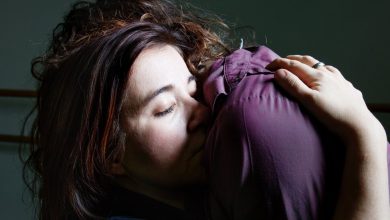The Toddler Was Bowlegged, Her Gait Awkward. What Was It?

The 17-month-old girl waddled down the hall of the nursing home in her furry pumpkin costume, gripping her Halloween booty. Masaru Furukawa, the child’s next-door neighbor in Spring Green, Wis., as well as her primary-care doctor, had taken his two young children trick-or-treating there, too. Watching his patient, the doctor was struck by her awkward side-to-side gait and bowed legs. “May I take a video of your daughter?” he asked the child’s mother. He wanted to send it to a friend, he explained — a pediatric orthopedist who specialized in children with funny walks.
The mother immediately agreed. She’d been worried about her child’s legs for months. Indeed, when she took her daughter to see Furukawa for her nine- and 12-month well-child visits, she asked about the girl’s crooked legs. Furukawa acknowledged that her legs were quite bowed. With most children this age, if you put their feet next to each other so that the ankles touched, their knees would touch as well, or at least be just a couple of finger-breadths apart. Her knees were so far apart you could fit a softball in the space. But, he reassured the mother, bowed legs — even those as curved as this little girl’s — were not uncommon in this age group, and they should straighten out once she started to walk. (She was cruising, or walking by holding onto things, but not walking on her own at that point.)
That afternoon at the nursing home was the first time Furukawa had seen the toddler walk any distance. Her gait was slow and awkward. Of course, the doctor explained to the child’s mother, they’re called toddlers because they toddle as they learn to walk and run, but she had been walking for a few months now, and he would expect her to be doing a little better. This was probably normal, but he trained with a pediatric orthopedist at American Family Children’s Hospital in Madison, Blaise Nemeth, who was an expert in children with gait issues. Furukawa knew that doctors from all over the Midwest consulted Nemeth about patients with bone problems.
Ghostly Bones
After seeing the video of the little girl in her pumpkin costume, Nemeth texted Furukawa: Looks OK to me. Still, he suggested getting an X-ray. It would probably be normal, but this way they would have a baseline so they could see if there was any change over the coming year.
Nemeth was wrong; the images were far from normal. In a normal X-ray, bones look bright white. Hers were a pale gray — so pale they looked almost translucent. And at the ends of each of the long bones in the thigh and calf, the part of the bone that lengthens, called the growth plate, the expected crisp, clear line was fuzzy. It looked as if the picture were out of focus in those spots alone.
Furukawa recognized the pattern immediately. This was rickets, a deficiency of one or more of the basic vitamins or minerals that make bones strong — usually vitamin D and calcium, or less frequently, phosphate. Vitamin D allows bodies to absorb calcium and phosphate, the two essential building blocks of strong bones. Historically, a lack of vitamin D in the diet was, and in some places in the world remains, the most common cause of rickets. It’s rare in the United States now because so many of the foods sold here are fortified with vitamin D. And so, these days rickets is mostly seen in babies breastfed for more than six months without getting vitamin D supplementation. Although this child was very small for her age, she didn’t look malnourished. And her mother reported that she was a good eater, routinely consuming foods rich in both vitamin D and calcium.
The blood tests Furukawa ordered only deepened the mystery. The girl’s calcium level was in the normal range, but her phosphate — a mineral essential for bone building — was exceedingly low. He turned to the medical literature to try to figure out why. If the deficiency wasn’t from too little coming in through the diet, then it had to be an issue with how much was going out, through the kidneys. There were, Furukawa recalled, inherited forms of hypophosphatemia — low phosphate levels — but most of these would affect the parents as well, and neither of her parents seemed to have any issues with bone development. What else could it be? Stumped, Furukawa reached out to the kidney specialists at UW Health in Madison. The first doctor he spoke with was also puzzled. Finally she said, “This is a problem for Neil.”
An Inherited Problem?
Dr. Neil Paloian was a pediatric nephrologist who ran the multidisciplinary bone clinic at UW Health in Madison. Every two weeks he and Nemeth, along with a geneticist and nutritionist, saw children who had abnormalities in the way their bodies grew bones. The girl was first seen in the clinic in early December. She was sitting on her mother’s lap when the team of doctors and other clinicians filed into the room. She observed them with interest at first, but when Paloian started asking her mother questions, she slipped off the lap to play with the toys that littered the room.
Paloian and Nemeth had reviewed the X-ray and labs. Like Furukawa, they weren’t sure exactly what was causing the little girl to lose so much phosphate that her bones were bending. From talking to the parents, it was clear that it wasn’t a problem of nutrition. And while there are other diseases that can cause this kind of phosphate wasting, children with those disorders usually look sick. This child, though small and bowlegged, looked quite healthy, and her exam was otherwise normal. They would need to get more tests, Paloian explained to the anxious parents. This could be an inherited disease known as X-linked hypophosphatemia. It was a rare disease, but they saw a lot of it in their specialty clinic. In order to prove that that’s what their daughter had, she would need genetic testing. And no matter what she had, it was essential that they get her phosphate levels as close to normal as possible. To do that, the child would have to take packets of phosphate three or four times a day. It tasted pretty bad, the doctor conceded, but it was the only way to strengthen her bones.
X-linked hypophosphatemia, as the name suggests, is a disease that is inherited on the X chromosome. In this disorder, there’s an error in the chromosome, which causes the kidneys to dump phosphate in the urine. Normally for a patient to have this, she would have to inherit it from one of her parents. Yet neither of this girl’s parents had any history of a bone problem. The abnormality can arise from a spontaneous mutation, but that is extremely rare. The genetic test came back positive; the child had X-linked hypophosphatemia. Her parents were tested as well. Neither of them had it. The girl was the first in her family but may not be the last. Her children, should she choose to have them, would have a 50-50 chance of inheriting this abnormal gene.
A New Drug
Treatment was not easy. The supplemental phosphate tasted awful. And she had to take it several times a day. Every day. The blood levels of the essential mineral began to rise, but her legs stayed bowed. That was the best you could do with this treatment. Replacing the missing mineral was enough to slow the disease but not to reverse the damage.
Two years after this child got her diagnosis, the Food and Drug Administration approved an orphan drug designed specifically for this disorder, called burosumab. Taken twice a month, the medication increases serum phosphate levels by reducing the amount lost through the kidneys.
Like so many of these new biopharmaceuticals, burosumab is expensive — roughly $150,000 a year. Lucky for her, her parents’ insurance was willing to pay for most of it. The drug has been amazing. She is 6 now, and though she remains one of the smallest in her class, her legs look normal to all but the most expert eye. Even more important: She can run and jump and have an active life. Her newest passion is gymnastics.
Lisa Sanders, M.D., is a contributing writer for the magazine. Her latest book is “Diagnosis: Solving the Most Baffling Medical Mysteries.” If you have a solved case to share, write her at Lisa.Sandersmd @gmail.com.




